Registered with the Registrar of Newspapers for India under R.N.I 53640/91
Vol. XXV No. 11, September 16-30, 2015
Madras Week
The Justice Party in Triplicane
A walk during Madras Week
by Sriram V.
It was documentary film-maker and photographer S. Anwar who first introduced me to Govi Lenin of Nakkeeran publications and his associate Prince Ennares Periyar. They were greatly interested in doing a walk connected with the Justice Party, he said, and wanted to know if Madras Musings would lend its name to it. I had a meeting with them and found that they had two routes in mind – one around T’Nagar where many of that party’s leaders are commemorated by name, and the other through Triplicane, where much of the party’s history actually took place. After a brief discussion we decided on the latter route for August 16th and agreed that it would be one of the walks done by Madras Musings for Madras Week.
The morning of the walk saw a fine drizzle, which kept many of the registrants safely in bed. But a few of us made it and were glad that we did, for the tour led by Govi Lenin brought to light several nuggets of Madras history, long forgotten. We began at the City Centre Mall, Radhakrishnan Road. This was once Raju Gramani Thottam and it was here that the Non-Brahmin Manifesto of the South Indian Liberation Front aka Justice Party was released in 1916. This year, therefore, marks the centenary of Dravidian politics, for it was with that party that the movement began.
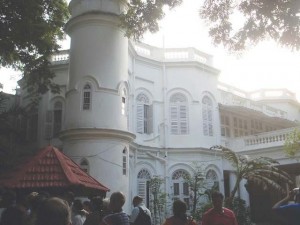
|
||
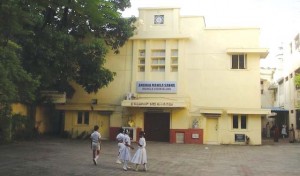 |
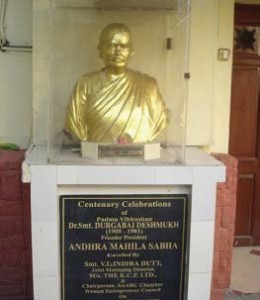 |
|
|
‘Mylapore and the Freedom Movement’ was the theme of a walk led by Sriram V during Madras Week. The walk included stops at C.P. Ramaswami Aiyar’s residence in Alwarpet (top) and the Andhra Mahila Sabha campus where the walkers paused at the statue of its founder Durgabai Deshmukh. |
||
We walked down Natesa Mudaliar Road, which connects Mylapore to Triplicane. This is named after Dr. C. Natesa Mudaliar (1875-1937), the founder of the Non-Brahmin movement. He was a prominent medical practitioner of the city and in 1912 helped found the Madras United League that focussed on improving the literacy of non-Brahmins in the Presidency. Though sidelined in later years, it cannot be denied that much of the initial impetus for the movement came from him.
Natesa Mudaliar Road leads to Irusappa Gramani Street, a thoroughfare that commemorates the Gramani community, several of whose members were followers of the Justice Party. Ma. Po. Sivagnanam (1906-1995), the Tamil scholar and also a Gramani, lived here. He played an important role in the agitation that led to Madras being retained as part of Madras State (later Tamil Nadu), during the linguistic division that led to the formation of Andhra. Ma Po Si was a Gandhian but in 1967, successfully contested the Assembly elections on a DMK ticket, winning from the T’ Nagar constituency.
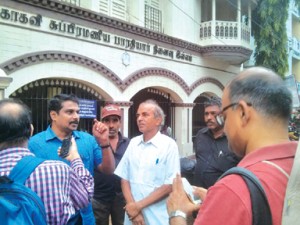
Lenin (second from left) at the Subramania Bharati’s house.
Our next stop was the house of Subramania Bharati (1882-1921), on Tulasinga Perumal Street. Now a well-maintained museum, this was an apt place to consider Bharati’s view of the Justice Party movement. Though he was a revolutionary in his strong dislike for the caste system, Bharati opined that the Justice Party, focussing as it did only on the local political movement, diverted attention from the greater good – the nationalist movement and the freedom struggle. The Justice Party when it came to power in the mid-1920s, would ban his works, a proscription that would end only in 1948.
From Tulasing Perumal Street we went to the Triplicane Tank. The waters of this tank and their maintenance was to see a bitter debate in the early 1900s in the Madras Corporation. In his capacity as Councillor for Triplicane, Dr. T.M. Nair (1868-1919) ordered that washing of clothes in the tank should be stopped forthwith and that the locals be taxed for the maintenance of the water. This was strongly opposed by Sir Pitti Theagaroya Chetty (1852-1925) and in the vote that ensued, Dr. Nair was defeated. He resigned from the Corporation and this was to embitter his relations with Sir Theagaroya. Matters would have remained thus and there had not Dr. C. Natesa Mudaliar brokered peace between the two in the interests of the non-Brahmin movement. The two came together by 1914 and, from then on, worked closely in the Justice Party. Dr. Nair went to England in 1919 to represent the non-Brahmin interests at the Houses of Parliament and died suddenly during his travel.
One of the earliest moves by the Madras United League under Dr. Natesa Mudaliar was the establishment of a hostel for non-Brahmin students. There had existed no such facility prior to this and its creation was to greatly encourage many non-Brahmins from the mofussil to enrol in the colleges of Madras. We, therefore, travelled next to Akbar Sahib Street, where Natesa Mudaliar’s hostel once existed but is untraceable now.
A coffee break en route at Adyar Ananda Bhavan was a good spot for a discussion on the electoral fortunes of the Justice Party. It came to power following the Montagu-Chelmsford reforms that allowed for a limited electoral franchise for the Legislative Councils. The Congress opted to stay out, citing Mahatma Gandhi’s non-cooperation principles but it spawned several outfits such as the Swarajists who contested the elections. The Justice Party came to power in 1920 with A. Subbarayulu Reddiar becoming the first Premier of Madras. He resigned shortly thereafter, making way for the Rajah of Panagal under whose leadership several landmark legislations were to be passed. The Communal GO of 1921 introduced proportional reservation of jobs on the basis of caste and religion and can be considered the beginning of the reservation policy in the whole of India. The Hindu Religious and Charitable Endowments Board was set up and took over the administration of all temple lands. This was opposed by the orthodox elements but received wholehearted support from the Paramacharya of Kanchi. The party, though outside office but lending support to Dr. P. Subbaroyan’s ministry in 1927, played a crucial role in helping Dr. Muthulakshmi Reddy table her anti-nautch Bill in Legislature.
We then moved to what is today Sangeetha Café on Bharati (Pycroft’s) Road. This was once Murali Café that proudly sported a board that claimed that entry was only for Brahmins. Those of other castes could take away food but could not eat there. This was where we remembered the role of Periyar E.V. Ramaswami Naicker (1879-1973) in the history of the Justice Party. He left the Congress in 1925 and by 1934 was firmly in the Justice Party’s fold. By then the party’s great days were over. It was steadily losing to the Congress and it was Periyar who transformed it into the Self-Respect movement, launching the Dravida Kazhagam. The Justice Party faded away thereafter. In the 1950s, Periyar was to get his followers to agitate against the Brahmin tag of Murali Cafe. A year-long legal battle, picketing and violence was to follow. It was the Paramacharya of Kanchi who finally convinced the owner of the hotel to remove the offending word. That ended the matter.
Our next stop was the house of Chinna Kuthoosi aka R. Thyagarajan (1934-2011) at Vallabha Agraharam, opposite the erstwhile Star Talkies. Though a Brahmin, he was to be a staunch member of the Self-Respect movement. He was a journalist and ideologue, who was widely respected by all elements in Dravidian politics. We ended the walk outside The Hindu’s old office at 100 Mount Road. From there, you get a good view of Periyar’s statue and also that of C.N. Annadurai (1909-1969). The latter, a staunch follower of Periyar, would break away from him and his DK on account of Periyar’s decision to marry Maniammai, a woman several years his junior. Anna’s split would see him launch the DMK in 1949 and become Chief Minister of Madras in 1967. He would legislate to have the State’s name changed to Tamil Nadu and the rest is a story we all know.
Periyar may have been an atheist but this was something that many of the Dravidian politicians chose to be ambivalent about. It was perhaps appropriate that our breakfast, which saw an animated discussion on the future of Dravidian politics, was at Saravana Bhavan, where we ate surrounded by pictures of Murugan, the Tamil deity, and of his – ardent devotee Kripananda Variyar.
A walk in the rain at Kelambakkam…
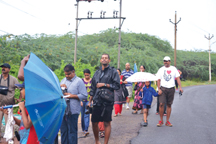
The Kelambakkam walk … in the rain.
The Madras Naturalists’ Society’s Kelambakkam Nature Walk, a part of Madras Week 2015 celebrations, provided participants sightings of 43 different birds: Despite heavy rain before and during the first half of the Walk, there were 21 ‘bravehearts’ who throughly enjoyed both the rain and the sightings, the big bonus being the three Greater Flamingos in all their glory. Sivkumar Hariharan led the walk: The Bird List of sightings is:
Spot-billed Pelican; Painted Stork; Asian Openbill; Little Grebe; Spot-billed Duck; Fulvous Whistling-duck; Common Coot; Large Egret; Little Egret; Cattle Egret; Grey Heron; Black-crowned Night Heron; Striated Heron; Black Bittern; Whiskered Tern; Black-headed Ibis; Glossy Ibis; Greater Flamingo; Green Bee-eater; Purple Swamphen; Pied Crested Cuckoo; Eurasian Curlew; Snipe sp.; Common Redshank; Little Stint; Black-winged Stilt; House Crow; Large-billed Crow; Red-wattled Lapwing; Ashy Prinia; Common Myna; Indian Pond Heron; Common Moorhen; Black Drongo; Pied Kingfisher; White-breasted Kingfisher; Red-vented Bulbul; Spotted Dove; Blue Rock Pigeon; Little Cormorant; Great Cormorant; Shikra; and Tailor Bird.
Vijay
Madras Naturalists’ Society
… & on a search for butterflies
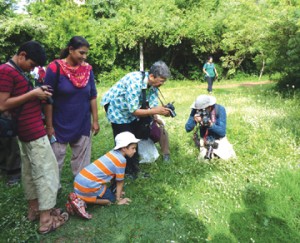
The ‘Butterfly Walk’ at the Adyar Tholkappiar Poonga during Madras Week was the first one ever conducted by the Madras Naturalists’ Society. It was led by Dr. R. Bhanumathi, Environmental Educationist. The walk began with an introduction on butterflies, morphology, role in our environment and tips on watching in the wild. The 25 participants were taken around the Poonga in small groups and introduced to spotting butterflies with their identification marks, wing patterns and flight behaviour. The two-hour walk resulted in spotting and identifying 24 species of butterflies (listed below) including the not-so-common ones like the Black Rajah, Common Grass Dart and Bush Hopper. The butterflies spotted were:
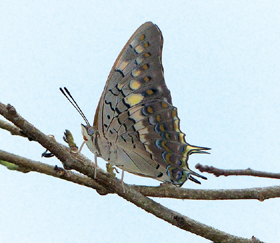
Black Rajah
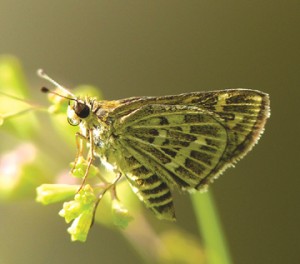
Common Grass
Dart.
Common Mormon (Papilio polytes); Lime Butterfly (Papilio demoleus); Crimson Rose (Atrophaneura hector); Small Grass Yellow (Eurema brigitta); Common Emigrant (Catopsilia Pomona); Small Salmon Arab (Colotis amata); Common Albatross (Appias albino); Psyche (Leptosia nina); Blue Tiger (Tirumala limniace); Striped Tiger (Danaus genutia); Plain Tiger (Danaus chrysippus); Common Crow (Euploea core); Black Rajah (Charaxes solon); Tawny Coster (Acraea violae); Common Leopard (Phalanta phalantha); Common Sailer (Neptis hylas); Chocolate Pansy (Junonia iphita); Lemon Pansy (Junonia lemonias); Forget-me-not (Catochrysops strbo); Lime Blue (Chilades lajus); Common Banded Awl (Hasora chromus); Common Grass Dart (Taractrocera maevius); Bush Hopper (Ampittia dioscorides); Parnara Swift (Parnana bada)
Winners all!
… at the Tamil Medium Quiz…

The annual Madras Quiz for Tamil medium city schools was held on August 22nd at a hall in the P.S. School campus, Mylapore. The quiz master was R. Revathi. The first prize was won by the team from Rani Meiyamnai Girls’ School, R.A. Puram – S. Aishwarya, M. Suganya. The second place was the team from St. Antony’s Girls’ School and 3rd was the team from Raja Mutaiah School, R.A. Puram.
… and at the power point presentation…
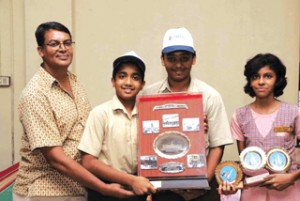
Kombai S. Anwar, documentary film-maker and photo-journalist, presented the first prize to the PSBB, T.P. Road, T. Nagar team, which won the annual Madras Day Power Point Presentation Contest at Sastri Hall, Luz. The theme this year was Heritage Churches of Madras. Mylapore Times organised this event too.
Vestiges of Madras at MCC
The Department of History, one of the oldest department in Madras Christian College, organised a two-day exhibition, “Vestiges of Madras”, to celebrate Madras Week. Taking place in early September, the exhibition helped make it what may be called a Madras Month. Exhibits, diverse in character, showcased the growth of Madras from its founding. On display were personal collections of maps, portraits, stamps, rare books, etc. of Dwaraknath Reddy, Managing Director, Nippo Batteries, D.H. Rao, Winston A. Henry and Roland Nelson.
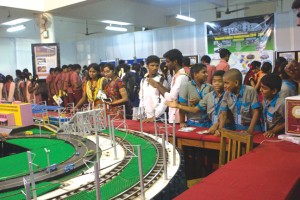 |
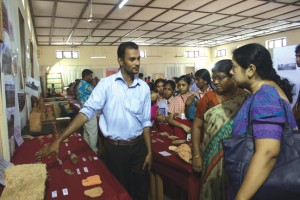 |
| At the Madras Christian College exhibition …explaining exhibits and interacting with the visitors… and the crowd to see how the trains run. |
The Archaeological Survey of India – Fort Museum, Chennai Circle – Chennai Port Trust, Department of Archaeology, Government of Tamil Nadu, Department of History, MCC, Government Museum, Chennai, Indian Air Force Station, Tambaram; Integral Coach Factory, Chennai, MCC Archives, and Madras Veterinary College, Chennai, all had contributed a variety of exhibits. The most attractive features of the exhibition were a running model from the railways, a model of a Mirage 2000 from the IAF, a speaking canon from the Fort Museum, and ship models from Port Trust.
Special lectures were delivered by D.H. Rao and Winston Henry on Buckingham Canal and Tramways in Madras, respectively. A food court with a variety of traditional cuisines was also organised.
Nalli Kuppuswamy Chetti, Chairman Nalli Silks, while inaugurating the exhibition, shared with a sense of nostalgia, his experiences of the city, particularly of T’Nagar. S. Muthiah delivered the valedictory address and hoped the exhibition would have made visitors proud of Madras’s history.
The target group of the exhibition was students and, as expected, it drew a lot of visitors from schools in the neighbourhood. Student from over 20 schools (about 2000 students) enjoyed the exhibits which some called a lifetime experience. Students and staff from Madras Christian College and other city colleges also had the same view.
On the trail of nuns & temples

A walk themed on the ‘Irish nuns in George Town’ (on right) was led by Vincent D’ Souza (in cap on right) during Madras Week.
* * *
Andhra Bank, Mylapore branch, organised a ‘Seven Sivan Temples’ tour in the Mylapore area to mark Madras Week (below).
Exhibiting the past

Students and faculty of the Sociology Dept of Sri Kanyaka Parameswari Arts and Science College for Women, Audiappa Naicken Street, George Town, hosted a half-day Madras Day exhibition of old photographs and home accessories used in years gone by. It also featured photographs of Kotwal Chawadi and the Sowcarpet/Mint area shot by the students. A few traders from the Moore Market/Lily Pondy complex also displayed old coins, gramophones, vinyl records, etc.
Highlighting built heritage
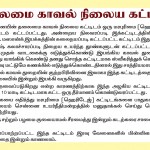
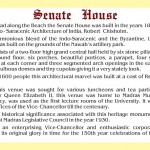
The billboards on the Marina with which Inner Wheelers 323 highlighted the city’s built heritage during Madras Day.
The Story of Madras
By A Special Correspondent
The Marina was indeed the perfect setting for the screening of the documentary The story of Madras….Chennai on the evening of August 22nd. As the waves lashed the shore and the stars twinkled that night (the rain Gods were merciful) history came alive for the duration of the film. For wasn’t on an extension of this sandy stretch that Francis Day of the East India Company arrived 376 years ago to found a new settlement. After braving the arduous journey by ship and an even more treacherous masula boat ride, Day arrived in what journalist, author, and well- known chronicler of Madras S. Muthiah calls no man’s sand.!!!!!
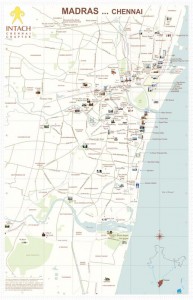
The film, which has been produced by the INTACH Chennai Chapter was an idea conceived by its Convenor Architect Sujatha Shankar a few years ago. The major highlight of the film is the commentary by S. Muthiah. It encapsulates over 300 years of history deftly and neatly, tells us about the many firsts that Madras scored, its institutions, its buildings and its glorious heritage and much more. No matter how many books on Madras you read there is simply nothing like hearing it from Muthiah, a man who knows the city best and who has history at his finger tips. Bringing to bear his knowledge and expertise honed by years and years of research Muthiah speaks as well as he writes and narrates the commentary in a chatty, conversational style. For someone like me who had been a Journalism student of Muthiah at Bharatiya Vidya Bhavan it was a throwback to those days when he would hold students in thrall with his lectures and have them hanging on to his every word. It was a wealth of information that he recalled so effortlessly that left many a viewer dumbstruck. “Imagine he has put in more than thirty years of research to give us this and that in a day and age when there were no computers, no Google, no internet, gushed a viewer. A motley crowd of history buffs, heritage lovers, architects, students, bureaucrats and other VIPs happily sat cross ¨Clegged on the sands and watched the film.
Talking about the making of the film, Sujatha Shankar discloses that the original plan was to record the commentary in a studio, but Muthiah preferred to talk to a live audience .Thus it was that the talk which was delivered at Madras Club to its members was seamlessly converted into a documentary by Sujatha with intelligent interspersing of visuals map drawings, old images, photographs and portraits to make the story come alive. Although it was released last year on Madras Day at the Amir Mahal by the Prince of Arcot, Mohammed Abdul Ali (the first copy was received by Mrs Y.G. Parthasarathy, Founder, Dean and Director Padma Seshadri Bala Bhavan Senior Secondary School, and copies distributed to several schools) the film has unlimited shelf life and is a great watch at any time. The visuals (Bhagat Singh and R Murali) and the music blended neatly and added value and meaning to the film.
Talking of the crowd response Sujatha Shankar describes it in one word, “awesome. Around seven hundred people watched it during the screening on August 22nd, and inspired by the overwhelming response a second screening was also held the same evening. Since copies of the film had been to several schools, those institutions too screened it for their students.
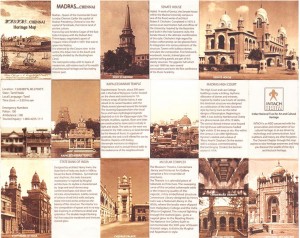
A Heritage map of Madras designed by Sujatha Shankar was also released on the occasion by Dr Rani Vedamuthu Chairperson, School of Architecture and Planning, Anna University, and the first copy was received by the Prince of Arcot, Mohammed Abdul Ali. The map which was made possible by TTK Healthcare is a foldable, pocket-sized map. “When you are somewhere in Madras that is Chennai and have some time to spare, the map will help you explore the vicinity, Sujatha says
The film is a must watch for heritage lovers, history buffs, students of architecture and history and anyone who cares about Madras that is Chennai.. It gives plenty of reasons to let our hearts swell with pride for, after all, wasn’t it in Madras that the seeds of modern India were sown .Such initiatives are indeed laudable as they help to keep alive, preserve and protect our natural heritage and built heritage.

